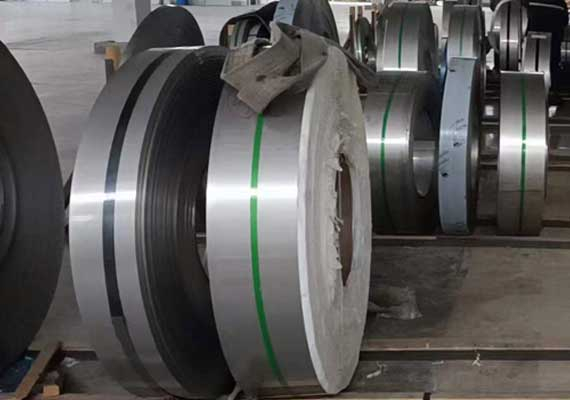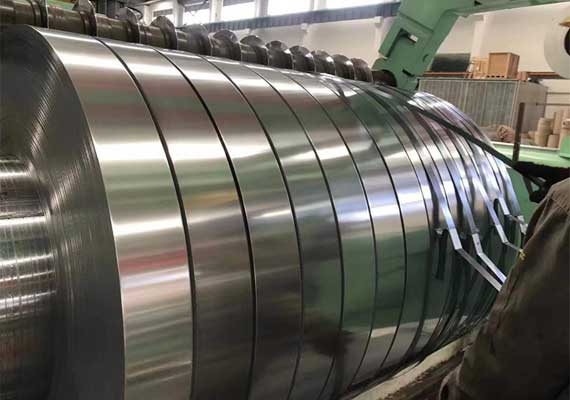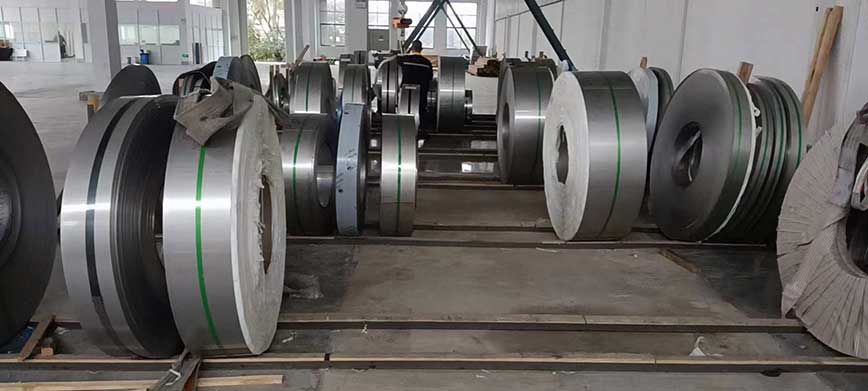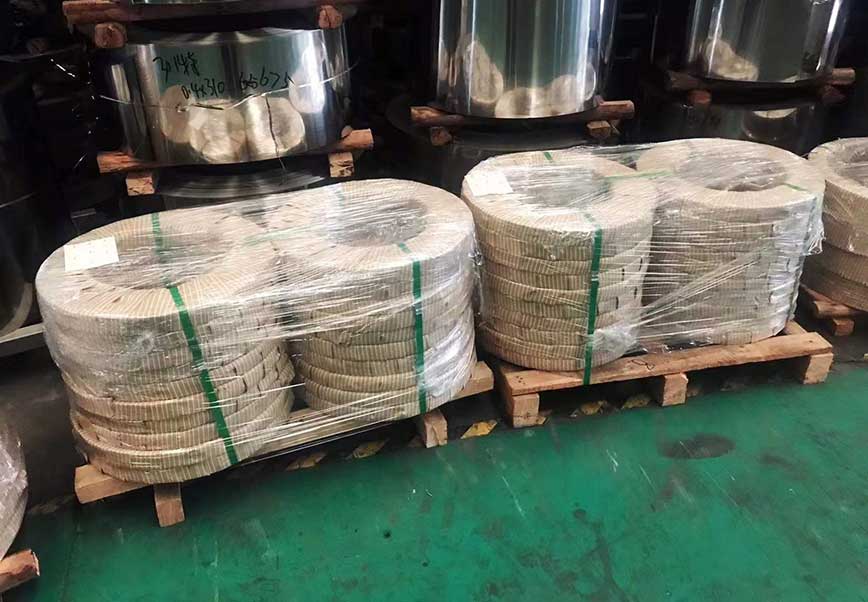
Send your inquiry: sales@cncdsteel.com

Send your inquiry: sales@cncdsteel.com
ASTM A240 304 Stainless Steel Strips 304 (UNS S30400, 1.4301) stainless steel is a universal stainless steel, it is widely used to make equipment and machine parts that require good comprehensive performance. In order to maintain the inherent corrosion resistance of stainless steel, the steel must contain more than 18% chromium and more than 8% nickel content. 304 stainless steel is a grade of stainless steel produced in accordance with the American ASTM standard. The most im…


Stainless steel

Stainless steel
304 (UNS S30400, 1.4301) stainless steel is a universal stainless steel, it is widely used to make equipment and machine parts that require good comprehensive performance. In order to maintain the inherent corrosion resistance of stainless steel, the steel must contain more than 18% chromium and more than 8% nickel content. 304 stainless steel is a grade of stainless steel produced in accordance with the American ASTM standard.
The most important elements in 304 stainless steel are Ni and Cr, but they are not limited to these two elements. The specific requirements are stipulated by the product standards. The common judgment in the industry is that as long as the Ni content is greater than 8% and the Cr content is greater than 18%, it can be considered as 304 stainless steel.

304 stainless steel is a common material in stainless steel, with a density of 7.93 g/cm3, which is also called 18/8 stainless steel in the industry. High temperature resistance of 800 degrees, with good processing performance and high toughness, it is widely used in industry and furniture decoration industry and food and medical industry.

304 is a versatile stainless steel, which is widely used to make equipment and parts that require good overall performance (corrosion resistance and formability). In order to maintain the inherent corrosion resistance of stainless steel, steel must contain more than 18% chromium and more than 8% nickel. 304 stainless steel is a grade of stainless steel produced in accordance with the American ASTM standard.
Common labeling methods on the market include 06Cr19Ni10 and SUS304, among which 06Cr19Ni10 generally means national standard production, 304 generally means ASTM standard production, and SUS 304 means Japanese standard production.

Chemical Composition of ASTM A240 Grade 304 Coil:
Physical Properties of Grade 304 stainless steel strip:
Tensile strength ab (MPa): >520
Conditional yield strength 0.2 (MPa) :>205
Elongation 5(%) :>40
Reduction of area (%) :>60
Hardness: ≤187HB; ≤90HRB; ≤200HV
Density (20C, Kg/dm2): 7.93
Melting point (C): 1398~1454
Specific heat capacity (0~100C, KJ*kg-1K-1): 0.50
Thermal conductivity (W-m-1.K-1): (100C) 16.3, (500C) 21.5
Linear expansion coefficient (10-6*K-1): (0~100C) 17.2, (O~500C) 18.4
Resistivity (20C, 10-60'm): 0.73
Longitudinal modulus of elasticity (20C, KN*mm2): 193
Mechanical Properties of 304 Stainless Steel Cold Rolled Coil:
Application of Stainless Steel 304 Strip and Coils:
304 stainless steel is the most widely used chromium-nickel stainless steel. As a widely used steel, it has good corrosion resistance, heat resistance, low temperature strength and mechanical properties; it has good hot workability such as stamping and bending without heat treatment. Hardening phenomenon (use temperature -196℃~800℃). It is resistant to corrosion in the atmosphere. If it is an industrial atmosphere or heavily polluted area, it needs to be cleaned in time to avoid corrosion. It is suitable for food processing, storage and transportation.
304 stainless steel has good processing properties and weldability. Plate heat exchangers, bellows, household products (category 1, 2 tableware, cabinets, indoor pipelines, water heaters, boilers, bathtubs), auto parts (windshield wipers, mufflers, molded products), medical appliances, building materials, chemicals, food industry , Agriculture, ship parts, etc.

Technical Data Sheet Strip | Product Name | ASTM A240 304 (UNS S30400, 1.4301) Stainless Steel Strips and Coils | Equivalent Materials | AISI 304, UNS S30400, SAE 304, DIN 1.4301, SUS304, TP304, X5CrNi18-10 | Type | Cold Drawn, Hot Rolled, Hot Forged | Standard & Specifications | GB,AISI,ASTM,DIN,EN,JIS | Available Grades | Stainless steel 301 / 302 / 303 / 304 / 304L / 310S / 316L / 316Ti / 316LN / 317L / 904L / 2205 / 2507 / 321 / 32760 / 253MA / 254SMo / 410 / 420 / 430 / Custom465 / XM-19 / S31803 / S32750 / S32205 / F50 / F60 / F55 / F60 / F61 / F65. | Monel 400 / Monel K-500 | Inconel 600 / Inconel 601 / Inconel 625 / Inconel 617 / Inconel 690 / Inconel 718 / Inconel X-750 | Incoloy A-286 / Incoloy 800 / Incoloy 800H / Incoloy 800HT | Incoloy 825 / Incoloy 901 / Incoloy 925 / Incoloy 926 | Nimonic 75 / Nimonic 80A / Nimonic 90 / Nimonic 105 / Nimonic C263 / L-605 | Hastelloy B / Hastelloy B-2 / Hastelloy B-3 / Hastelloy C / Hastelloy C-276 / Hastelloy C-22 | Hastelloy C-4 / Hastelloy C-2000 / Hastelloy G-35 / Hastelloy X / Hastelloy N | PH stainless steel 15-5PH / 17-4PH / 17-7PH | Thickness | hot rolled 2.5mm-200mm | cold rolled 0.3mm - 6mm | Width | hot rolled 1000mm-3500mm | cold rolled 10mm - 2000mm | Finish | 2B, ****, HL, NO.4, 4K, 8K, sandblast, BA | Packing | Wooden box, wooden crame/pallet, iron frame | Inspection | TUV,BV,ABS,LR and so on | Application | Construction, Chemical, Pharmaceutical & Bio-Medical, Petrochemical & Refinery, Environmental, Food Processing, Aviation, Chemical Fertilizer, Sewage Disposal, Desalination, Waste Incineration etc. | Processing Service | Machining : Turning / Milling / Planing / Drilling / Boring / Grinding / Gear Cutting / CNC Machining | Deformation processing : Bending / Cutting / Rolling / Stamping | Welded | Forged | Delivery Time | 7-40 days | Trade Term | FOB CIF CFR CIP DAP DDP EXW | Payment | T/T, L/C,D/A,D/P, Western Union,MoneyGram,According to customer requirements payments for offline orders. | Transportation | By air, by sea, by train, by truck | Sample | Free | Warranty | Trade assurance after sales service | |
Specification | C | Si | Mn | P | S | Cr | Ni | Mo | SUS304 | ≤0.08 | ≤1.00 | ≤2.00 | ≤0.05 | ≤0.03 | 18.00-20.00 | 8.25~10.50 | - | |||||||||||||||||||||||||||||||||
Performance | ASTM A240 and ASME SA-240 | 304 | 304L | 304H | 0.2% Offset yield strength, |
|
|
| Ultimate tensile strength, |
|
|
| Percent extension (2 inches or 51mm) |
|
|
| hardness, |
|
|
| ||||||||||||||||||||||||||||||
Products are widely used in construction, machinery, coal mining, chemical industry, electric power, railway vehicles, automobile industry, highways, bridges, containers, sports facilities, agricultural machinery, petroleum machinery, prospecting machinery, greenhouse construction and other manufacturing industries
The corrosion resistance of stainless steel coils decreases as the carbon content increases. Therefore, the carbon content of most stainless steels is low, up to 1.2%, and some steels have a low ωC (carbon content) of even less than 0.03% (such as 00Cr12). The main alloying element in stainless steel coil is Cr (chromium). Only when the Cr content reaches a certain value, the steel has corrosion resistance. Therefore, the goods Cr (chromium) content of at least 10.5%. Stainless steel coil also contains Ni, Ti, Mn, N, Nb, Mo, Si, Cu and other elements.
Most of the requirements for use are to maintain the original appearance of the building for a long time. In determining which type of goods to choose, the main considerations are the required aesthetic standards, the corrosiveness of the local atmosphere and the cleaning system to be used. However, other applications are increasingly seeking structural integrity or impermeability. Examples include roofs and sidewalls of industrial buildings. In these applications, construction cost to the owner may be more important than aesthetics, and the surface may not be very clean. The use of 304 stainless steel coils in dry interior environments is quite effective.
Weldability. Different product uses have different requirements for weldability. A class of tableware generally does not require weldability, even including some cookware companies. However, most products require raw materials with good weldability, such as second-class tableware, insulation cups, steel pipes, water heaters, water dispensers, etc.
Corrosion resistance. Most stainless steel coil products require good corrosion resistance, such as Class I or Class II tableware, kitchen utensils, water heaters, water dispensers, etc.
Polishing performance. In today’s society, stainless steel coil products in the production process are generally polished, only a few products such as water heaters, drinking fountains, etc. do not need to be polished. Therefore, this requires raw materials with good polishing performance.
1. The need for pre-treatment
Pretreatment is an important treatment step before the surface of
stainless steel coil parts enter surface treatment (including pickling,
chemical polishing and electrochemical polishing, electroplating,
passivation, black coating, coloring, chemical treatment, etc.). During
the forming process of goods parts, the surface may adhere to oil
stains, burrs, rough surfaces and oxides. Therefore, before surface
treatment, oil stains, burrs, uneven surfaces and oxides must be removed
in order to obtain subsequent satisfactory results through processing.
2. Treatment of removed dirt
Stainless steel coil surface pretreatment in the need to remove the dirt
can be divided into two categories: organic and inorganic substances.
(1) organic dirt. Including mineral oil (such as diesel, oil, paraffin,
gypsum, etc.) and animal oil, vegetable oil (such as soybean oil,
camellia oil, rapeseed oil, lard, butter, etc.). These oils are mainly
from the stainless steel coil zero cattle processing process used in the
lubricant. , cutting oil, quenching oil, polishing paste and polishing
paste, and fingerprints.
(2) Inorganic dirt. Including dirt, dust particles, oxides and other
contaminants generated during the heat treatment process.
3. Pretreatment steps for stainless steel coil parts
(1) The surface is mechanically leveled. Eliminate the roughness of the
stainless steel coil surface, through mechanical polishing and grinding
to achieve a surface finish.
(2) Degreasing. Remove the surface oil and dirt.
(3) Acid washing. Remove the oxides on the surface.
(4) Weak corrosion. Activates the surface to be treated, removes the
surface passivation film, and exposes the metal crystal structure.
Stainless steel is a high-alloy steel, with a large resistance to rolling deformation. In order to carry out high-efficiency and high-precision rolling, rigid rolling mills should be used, generally multi-roller cold rolling mill.
Special welding process is also a feature of cold-rolled stainless steel coil production.
In the production process of cold rolled stainless steel coil, the raw material (hot rolled coil) should be annealed, intermediate annealing should be carried out in the cold rolling process, and the final product should be annealed, so annealing is an important part of the production.
Cold-rolled stainless steel is a high-grade steel products, there are strict requirements for surface quality. Not only are metallurgical defects caused by the previous process not allowed, but also obvious defects caused by the cold rolling process.
Send your inquiry / assessment to Us. Anything need us ,please don’t hesitate contact us here! we will keep it secret for you !

Send your inquiry / assessment to Us. Anything need us ,please don’t hesitate contact us here! we will keep it secret for you !
